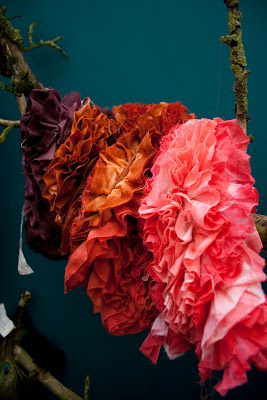Two graduate projects from Lucerne University Design and Art are exhibited at Heimtextil. “In the Company of Things“ by Martina Gilgen reflects on ordinary objects we mostly take for granted: We value them most when we mislay them. „La Martyre“ by Andrea Boog are variations on a poem from Baudelaire‘s classic „Les fleurs du mal“ highlighting the sensual and voluptous splendors of decay.
At Lucerne University, both the realisation of textile designs and their presentation reflects the ecological and economic context. Artistic abilities and analysing the needs of potential customers are of equal importance to create harmonious concords between aesthetic values and target markets.
„La Martyre“
Sultry as a hothouse, sumptuously decaying, a bouquet sighs its last into its
Crystal coffin -. Guilty joys, passion’s mysterious rites, secret splendours glimpsed through heavy folds of voluptuous draperies ensnare the gaze and overwhelm the senses. Did he kiss you once farewell? Rest in peace, your picture is immortal.
«Eine Märtyrerin» (frei nach Baudelaire aus „Les fleurs du mal“)
Lau wie ein Treibhaus und unheilschwanger überall,
letzte Seufzer haucht ein Blumenstrauss in einem Sarge aus Kristall.
Sündhaftes Vergnügen, geheimnisvolle Leidenschaft wird enthüllt.
Erschaffen in verborgener Pracht, üppige Gewänder, unsere Blicke sind gefangen.
Die Sinne sind wund vor Überdruss! Hatte er ihr einen Abschiedskuss gegeben?
Ruhe in Frieden – Dein Bild wird ewig leben.
In the Company of Things
How such ordinary things can gratify us.
Though mostly we take them for granted,
when chance mislays them, and we must find them again,
how they glow delighted in our attention.
Casting their peripheral images on the textile screen brings their companionship to light.
Vom Wesen der Dinge
Alltägliche Gegenstände erleichtern und verschönern so manchen Moment unseres Lebens. Als Mittel zum Zweck gehen sie oft in der Selbstverständlichkeit unter. Doch einmal verlegt und wiedergefunden erfassen sie überraschend unsere Aufmerksamkeit. Auf der textilen Ebene wird das ursprüngliche Erscheinungsbild verfremdet, und die treuen, unscheinbaren Begleiter werden in ein anderes Licht gerückt.

Textildesign
Bachelor
Produkt- und Industriedesign
Leitung
Prof. Tina Moor
Informationen
Magalie Jost Naranjo
+41 41 228 69 71
magalie.jostnaranjo@hslu.ch
Textildesign setzt ein Interesse für Farbe, Material, Musterung und Technologie voraus.
Entwerfen, Umsetzen und Inszenieren von Textilien geschehen in einem ökologischen und wirtschaftlichen Kontext.
Es ist ebenso wichtig, die Anforderungen der potenziellen Kunden zu kennen,
das gestalterische Können anzuwenden und mit der Zielgruppe in Einklang zu bringen.
Textile Design
Bachelor
Product- und Industrial Design
Head
Prof. Tina Moor
Information
Magalie Jost Naranjo
+41 41 228 69 71
magalie.jostnaranjo@hslu.ch
Textile Design assumes student interests in colour, material, patterning and technology.
Both the realisation of designs in textiles, and their presentation, take place in an ecological and an economic context.
Artistic abilites and knowledge of the needs of potential customers are of equal importance in creating harmonious concords between aesthetic values and target markets.










